What Is a Hydroponic Air Conditioner and How Does It Work?
Maintaining the right temperature and humidity is crucial for successful hydroponic gardening. A hydroponic air conditioner helps regulate these factors, ensuring optimal plant growth and preventing heat-related stress. Unlike traditional cooling systems, these air conditioners are designed to maintain a controlled environment, improving efficiency in indoor gardens and grow rooms. In this guide, we’ll explore how hydroponic air conditioners work, their benefits, and tips for selecting the right system for your setup.
Hydroponics is revolutionizing modern agriculture, allowing growers to cultivate plants without soil while maintaining full control over environmental conditions. A hydroponic air conditioner plays a critical role in stabilizing temperature, humidity, and airflow—key factors that influence plant health and yield.
In this guide, we’ll explore how a hydroponic air conditioner works, its importance in climate control, and the major benefits it offers for hydroponic farming.
Understanding Hydroponic Climate Control
Hydroponic systems require precise environmental conditions to ensure optimal plant growth, nutrient absorption, and disease prevention. Temperature, humidity, and airflow must be regulated continuously, and this is where a hydroponic air conditioner becomes essential.
1. Importance of Temperature Control in Hydroponics
- Most hydroponic plants thrive at a temperature range of 65-75°F (18-24°C).
- Excessive heat can reduce oxygen levels, causing root stress and stunted growth.
- Low temperatures can slow down nutrient uptake, weakening plant metabolism.
2. Managing Humidity for Better Growth
- Humidity levels should be maintained between 50-70% for optimal transpiration and nutrient absorption.
- High humidity increases the risk of mold, mildew, and fungal infections.
- A hydroponic AC unit removes excess moisture, preventing diseases and improving plant resilience.
3. Role of Air Circulation
- Proper air circulation distributes CO₂ evenly, helping plants photosynthesize more efficiently.
- Stagnant air can cause hot spots and encourage pest infestations.
- Using air diffusers and fans alongside air conditioners optimizes air distribution.
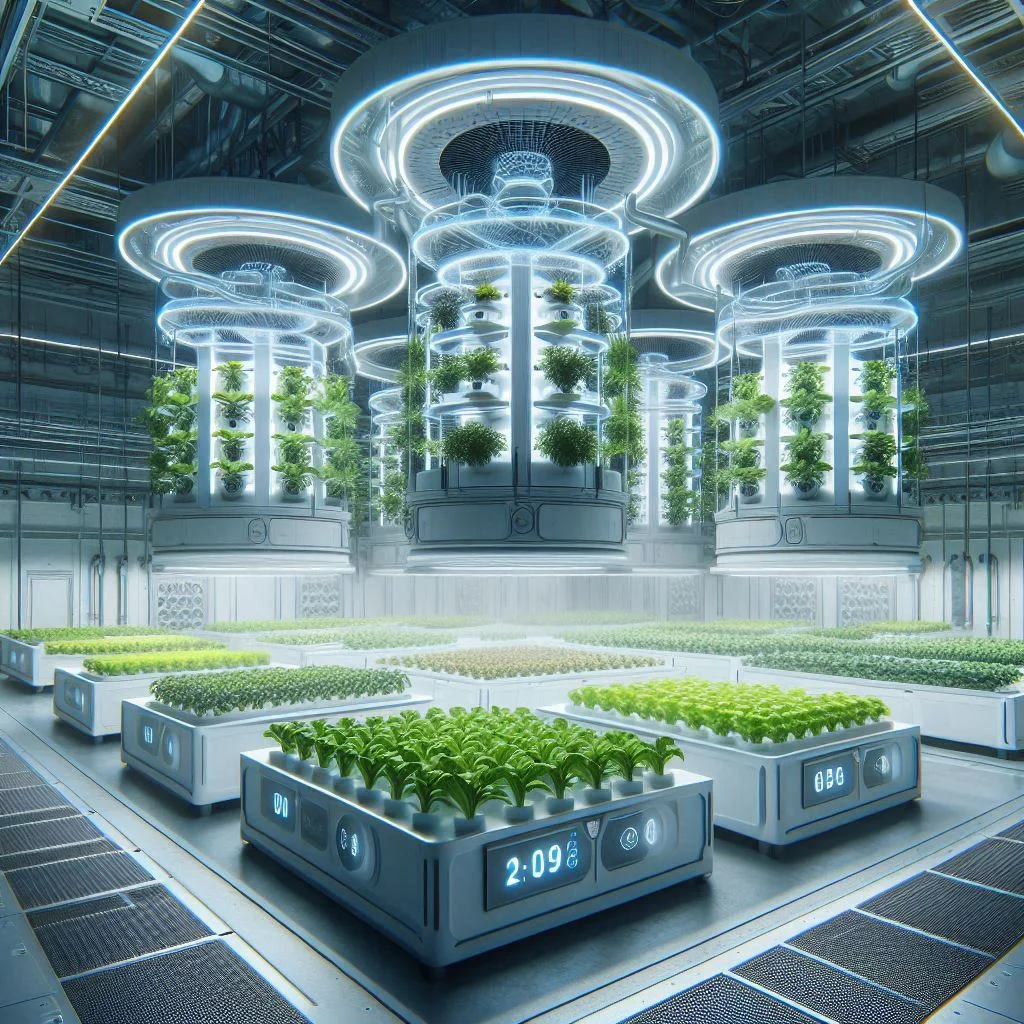
Role of Air Conditioners in Hydroponic Systems
A hydroponic air conditioner is specifically designed to maintain the ideal temperature, remove excess humidity, and ensure proper airflow. Unlike standard AC units, hydroponic ACs are built to run continuously while maintaining stable climate conditions.
1. Types of Hydroponic Air Conditioners
- Mini-Split Air Conditioners – Ideal for small grow rooms, offering energy efficiency and precise temperature control.
- Ducted HVAC Systems – Used for large-scale hydroponic farms, distributing conditioned air evenly.
- Portable AC Units – Suitable for small setups or temporary cooling needs.
2. How Hydroponic AC Units Differ from Standard ACs
- Designed to handle higher humidity levels in grow rooms.
- Equipped with advanced filtration systems to prevent mold and pathogens.
- Some models integrate with CO₂ controllers for enhanced plant growth.
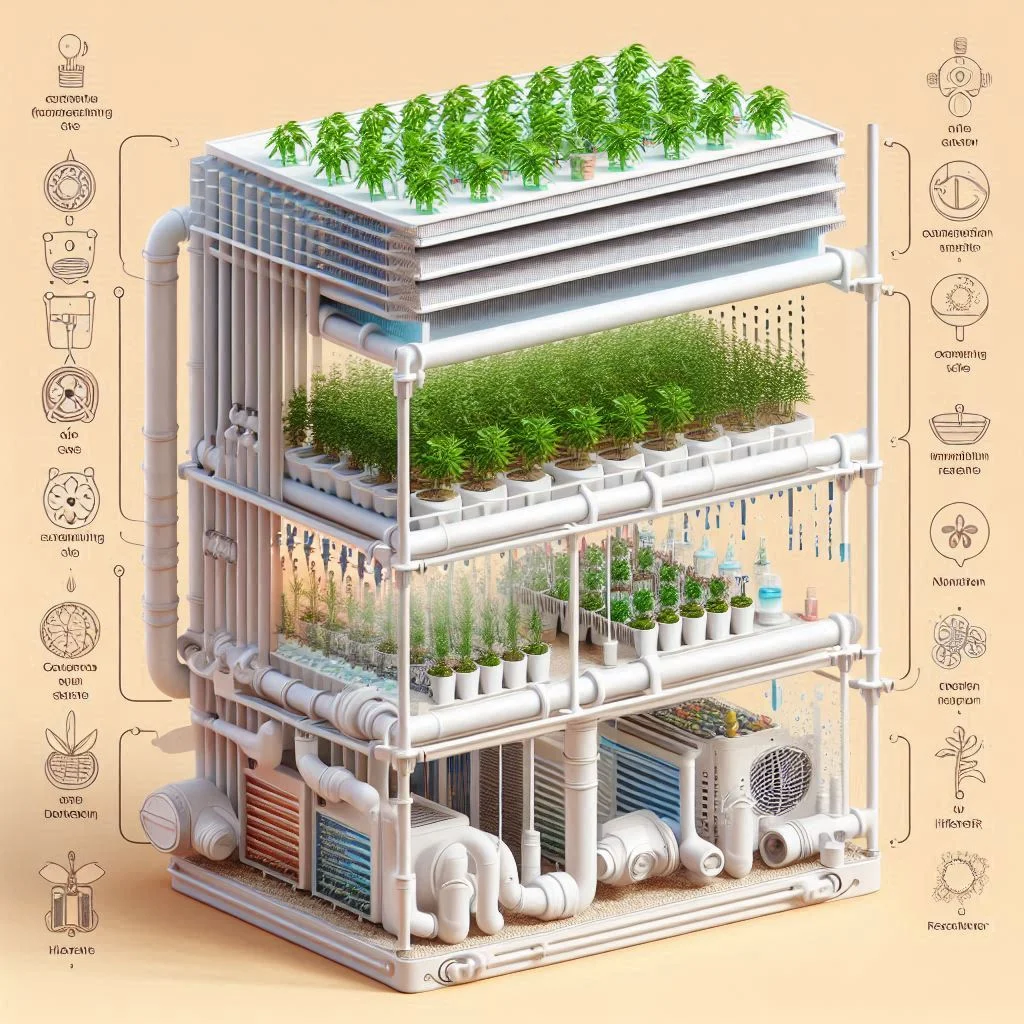
Key Benefits of Using Air Conditioning in Hydroponics
Investing in a hydroponic air conditioning system significantly enhances plant health, yield, and efficiency. Here’s why:
1. Maximized Plant Growth and Yield
- Stable temperatures and humidity levels optimize nutrient absorption and photosynthesis.
- Prevents stress-induced stunted growth, ensuring higher yields and faster harvests.
2. Disease and Pest Prevention
- Air conditioners reduce excess humidity, minimizing fungal and bacterial growth.
- Improved air circulation prevents stagnant air, reducing pest infestations.
3. Energy Efficiency and Cost Savings
- Modern hydroponic ACs use energy-efficient cooling mechanisms, reducing operational costs.
- Advanced models come with smart controls, allowing automated adjustments based on real-time temperature and humidity readings.
4. Better Air Quality and CO₂ Distribution
- Hydroponic air conditioners integrate air filtration systems, removing pollutants and ensuring clean air.
- Proper airflow ensures even CO₂ distribution, essential for plant metabolism and photosynthesis.
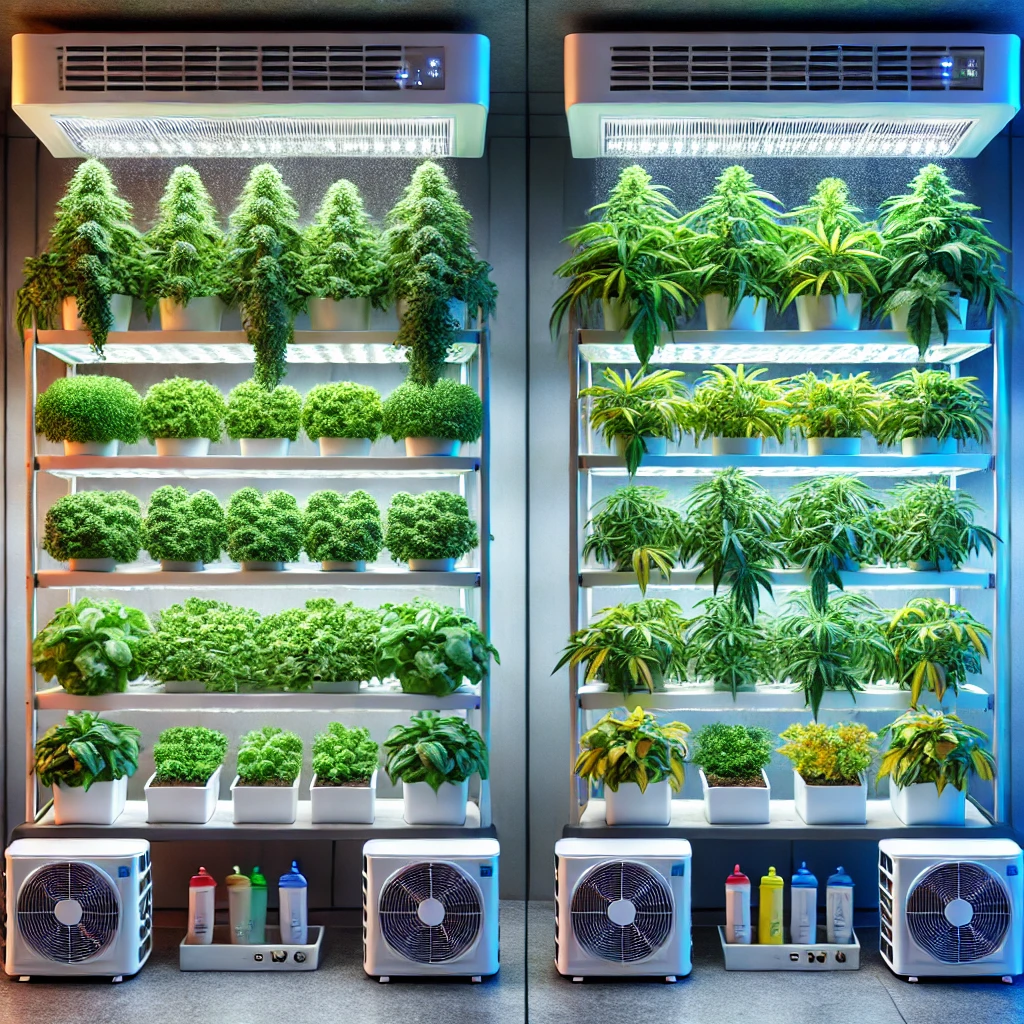
How to Make Your Own Air Diffuser for a Hydroponic System
In hydroponic farming, maintaining optimal air circulation is just as crucial as water quality and nutrient levels. Proper air distribution ensures oxygen reaches the roots, prevents stagnant air pockets, and enhances plant growth. One effective way to achieve this is by using an air diffuser—a simple yet powerful tool that helps distribute air evenly within a hydroponic system.
This guide will cover:
The importance of air circulation in hydroponic setups
A step-by-step DIY guide to making an air diffuser
The best materials and tools to use for long-lasting efficiency
Let’s get started!
Importance of Air Circulation in Hydroponic Setups
A hydroponic system relies on a controlled root environment where oxygenation and air circulation directly impact plant health and nutrient absorption. Here’s why proper air diffusion is essential:
1. Prevents Root Suffocation
- In hydroponic systems, plant roots are submerged in nutrient-rich water, making oxygen supply crucial for root respiration.
- Without proper air circulation, roots can suffocate, leading to poor growth or even root rot.
2. Enhances Nutrient Uptake
- Oxygen stimulates root metabolism, allowing plants to absorb nutrients more efficiently.
- A well-oxygenated hydroponic system supports faster plant growth and higher yields.
3. Eliminates Stagnant Air and Prevents Pathogens
- Poor airflow leads to moisture buildup, creating the perfect environment for fungal infections, mold, and algae growth.
- A properly installed air diffuser prevents stagnant zones, reducing the risk of disease and pests.
4. Promotes Uniform CO₂ Distribution
- CO₂ is essential for photosynthesis, and poor air circulation causes uneven CO₂ levels.
- An air diffuser evenly distributes CO₂, ensuring optimal plant growth.
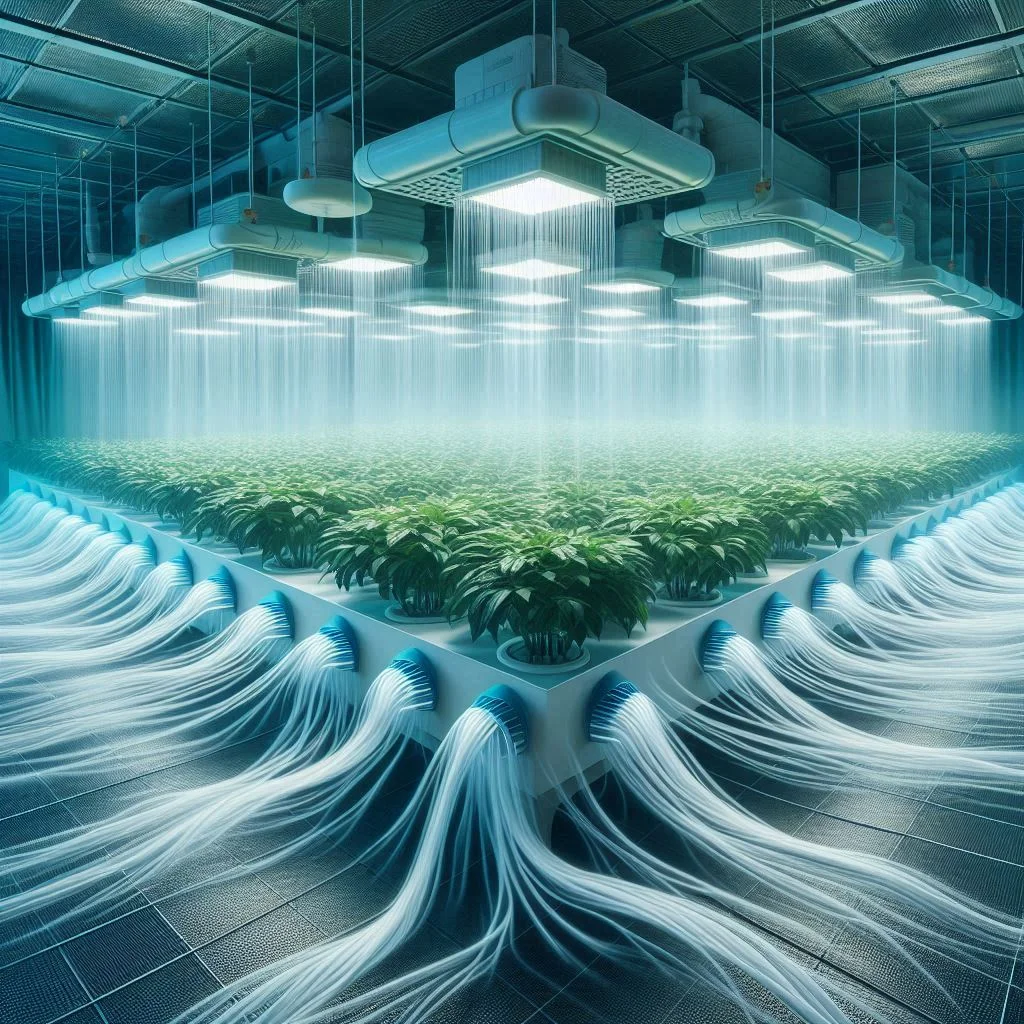
Step-by-Step Guide to Making an Air Diffuser for Your Hydroponic System
Creating a DIY air diffuser is cost-effective and easy. Follow these simple steps to enhance your hydroponic setup:
Step 1: Gather Your Materials
You’ll need the following:
Air Pump – To generate airflow (Choose a pump based on your system size)
Airline Tubing – To connect the air pump to the diffuser
Porous Stone or Ceramic Disc – Acts as the main air-diffusing element
Silicone Sealant (Optional) – To create airtight connections
Scissors & Drill – For cutting and making adjustments
Step 2: Assemble the Air Diffuser
Cut the airline tubing to your desired length, ensuring it reaches all necessary areas of the hydroponic tank.
Attach one end of the airline tubing to the air pump outlet.
Connect the other end to the porous stone or ceramic disc, which will diffuse air into fine bubbles.
Seal any loose connections with silicone to prevent air leaks.
Step 3: Install the Air Diffuser in the Hydroponic System
Place the air diffuser at the bottom of the reservoir for maximum oxygen distribution.
Secure it with weights or suction cups to keep it submerged.
Turn on the air pump and observe the bubble distribution—adjust placement if needed.
Step 4: Optimize and Maintain Your DIY Air Diffuser
- Check air bubbles—they should be small and uniform for optimal oxygenation.
- Clean the air diffuser regularly to prevent clogging from algae or mineral buildup.
- Replace porous stones every few months for consistent performance.

Best Materials and Tools for DIY Air Diffusers
Using high-quality materials ensures that your DIY air diffuser works efficiently for a long time. Here’s what to consider:
1. Choosing the Right Air Pump
- For small hydroponic systems: A low-output air pump (1-5 L/min) works well.
- For medium to large setups: Opt for a high-output air pump (10+ L/min) with multiple outlets.
2. Best Airline Tubing Options
- Silicone airline tubing – Flexible, durable, and resistant to kinks.
- PVC airline tubing – Cheaper but less flexible and prone to cracking over time.
3. Selecting the Perfect Diffuser Stone
- Ceramic air stones – Provide fine bubbles, ideal for maximizing oxygenation.
- Porous air stones – Affordable and widely available, but require frequent cleaning.
- Disc diffusers – Large flat stones that distribute even airflow in bigger reservoirs.
4. Additional Tools for Assembly
- Suction cups or weights – To keep the diffuser submerged at the bottom.
- Check valves – Prevent water backflow into the air pump, ensuring safety.
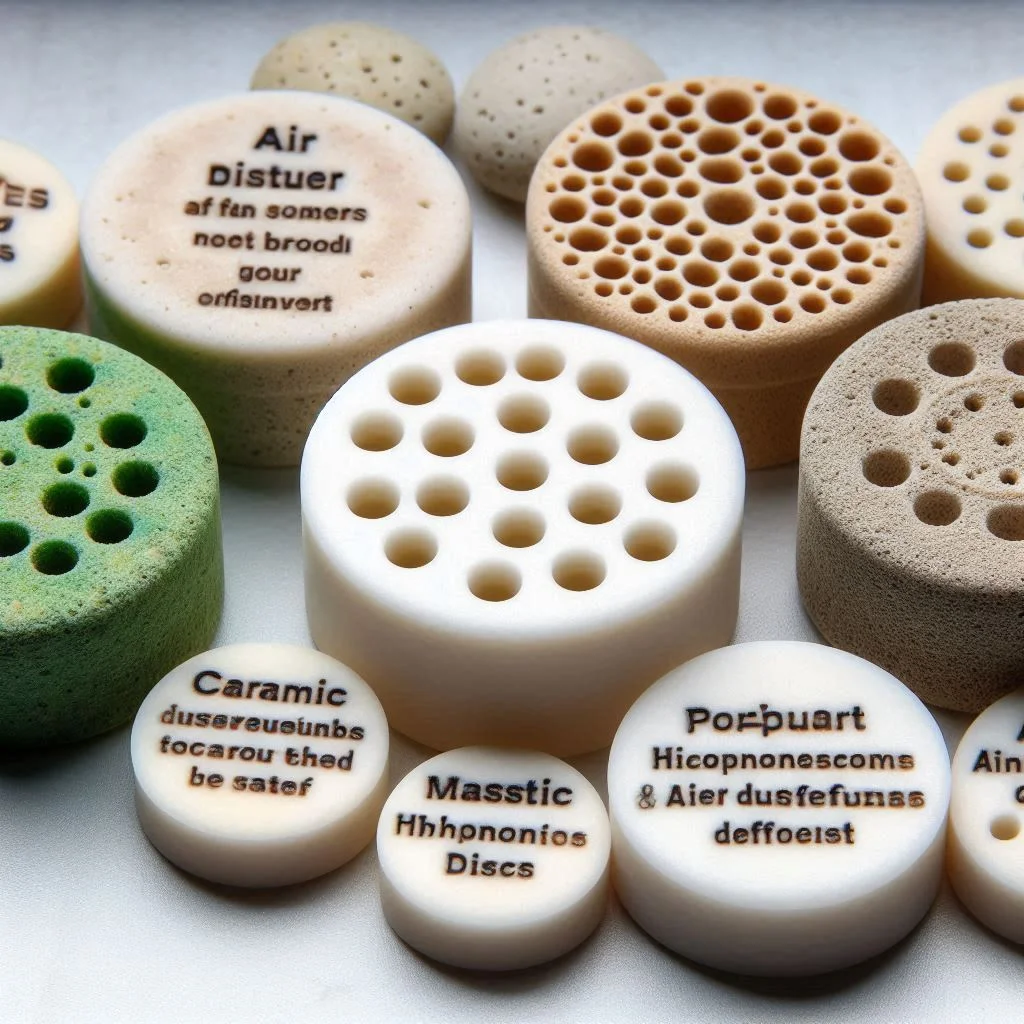
The Role of Plant Hormones and Nutrients in Hydroponic Systems
Hydroponic farming is revolutionizing modern agriculture by enabling soil-less plant growth with precisely controlled nutrient and environmental conditions. However, just like in traditional farming, plant health and productivity in hydroponics depend on hormones, nutrients, and environmental factors.
This article will explore:
How Auxin, Ethylene, and Potassium impact hydroponic plant growth
The vascular system’s role in nutrient and water transport
The importance of climate control in preventing plant diseases
Understanding these factors will help you optimize your hydroponic system for maximum plant health and yields.
How Auxin, Ethylene, and Potassium Affect Plant Growth
1. Auxin: The Growth Regulator
Auxin is a crucial plant hormone that regulates cell elongation, root development, and phototropism (growth toward light). In hydroponic systems, Auxin plays a vital role in:
- Encouraging strong root growth for better nutrient absorption
- Promoting vertical plant growth while preventing excessive lateral branching
- Enhancing fruit and flower formation, improving yields
How to Boost Auxin in Hydroponics
- Use natural auxin sources like kelp extract or synthetic Indole-3-Acetic Acid (IAA)
- Maintain optimal root zone temperature (65-75°F) to stimulate auxin production
- Ensure proper lighting conditions to regulate auxin-driven phototropism
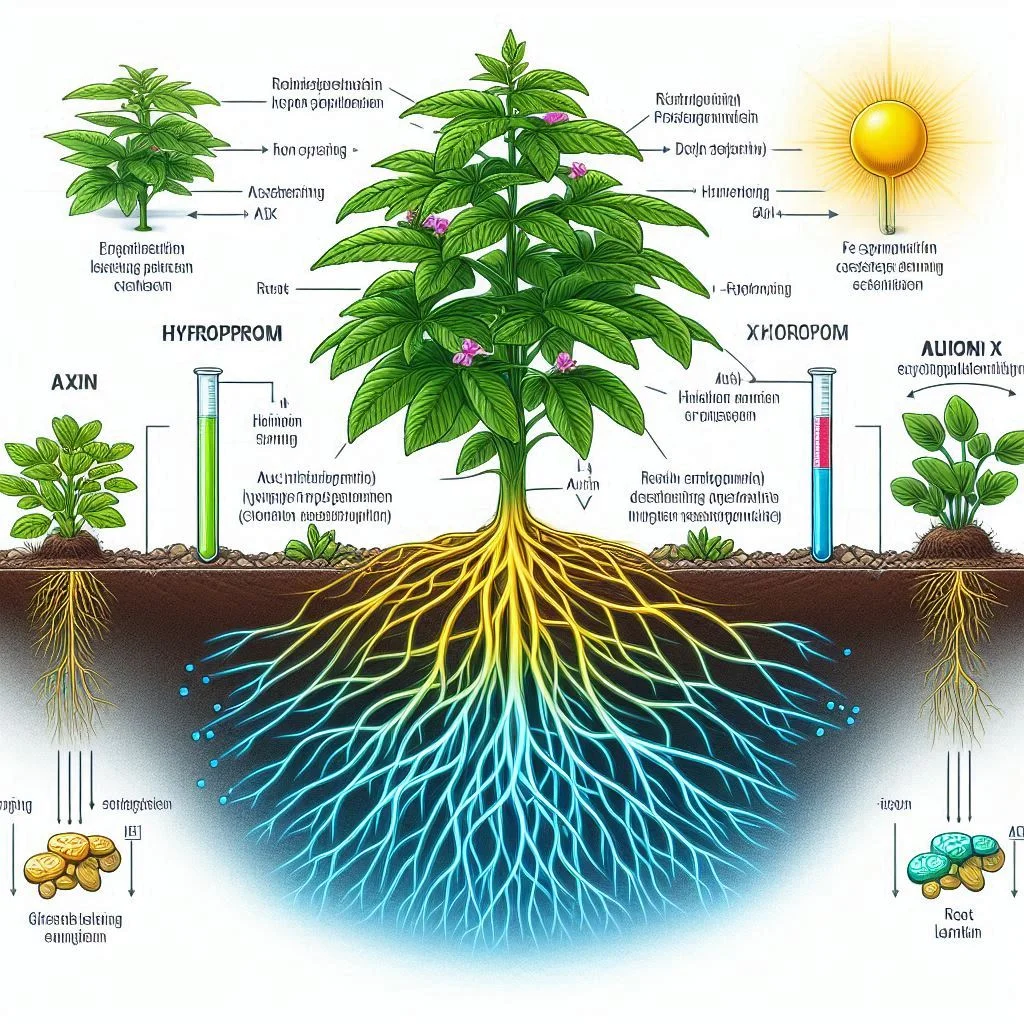
2. Ethylene: The Ripening Hormone
Ethylene is a gaseous plant hormone responsible for:
- Ripening fruits and vegetables
- Shedding old leaves and flowers
- Responding to stress (e.g., heat, disease, mechanical damage)
In hydroponic environments, uncontrolled ethylene levels can cause:
Premature fruit ripening, leading to reduced shelf life
Leaf yellowing and dropping if ethylene builds up in enclosed grow spaces
Delayed root development, affecting nutrient uptake
Managing Ethylene in Hydroponics
- Use proper ventilation and air circulation to prevent ethylene buildup
- Avoid over-mature plants in the system to reduce excessive ethylene production
- Incorporate activated carbon filters to absorb excess ethylene gas
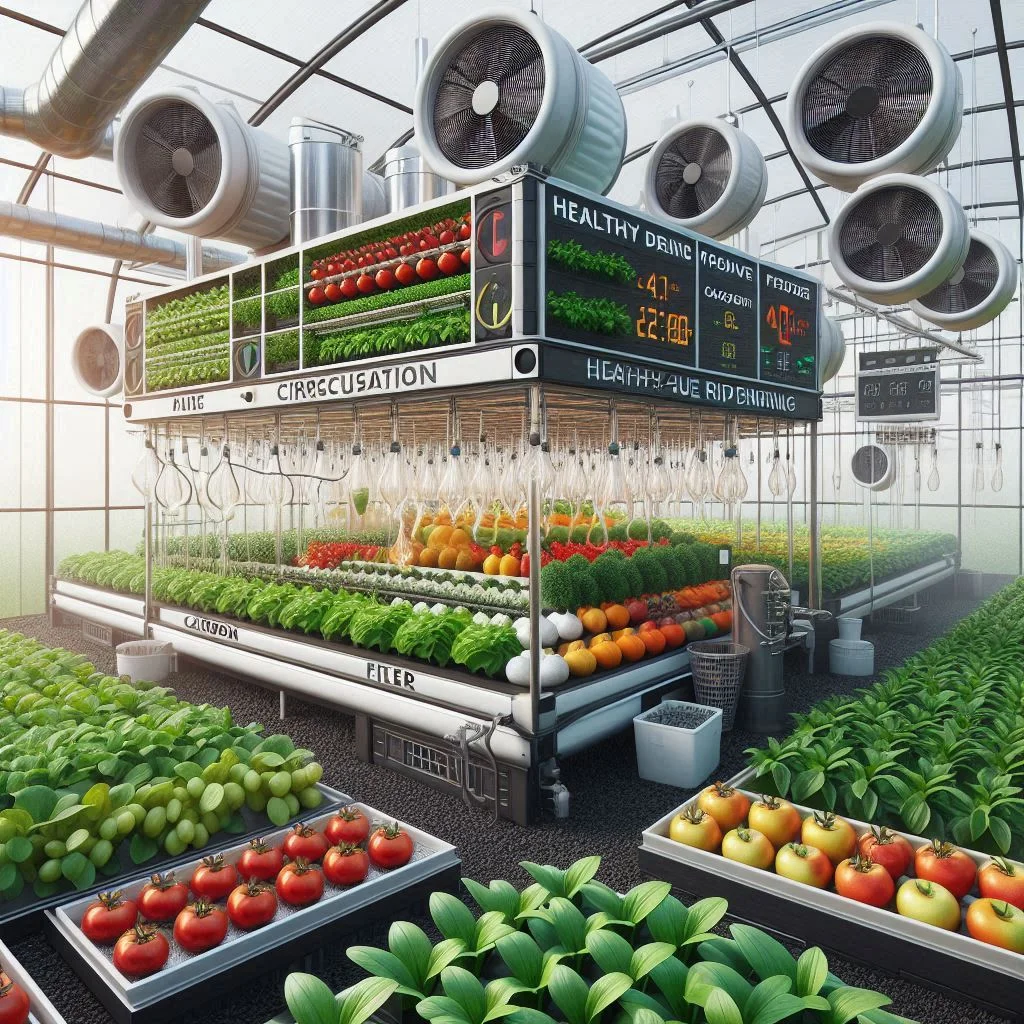
3. Potassium: The Essential Nutrient for Hydroponic Plants
Potassium (K) is one of the three primary macronutrients (N-P-K) and is crucial for:
Regulating water uptake and preventing dehydration
Activating enzymes for photosynthesis and energy production
Strengthening plant immunity against diseases and environmental stress
Signs of Potassium Deficiency in Hydroponics
Yellowing leaves with brown edges
Weak, slow-growing plants with reduced yields
Increased vulnerability to fungal infections
How to Maintain Optimal Potassium Levels
- Use potassium-rich fertilizers like Potassium Sulfate (K₂SO₄) or Potassium Nitrate (KNO₃)
- Maintain an EC (electrical conductivity) between 1.2 – 2.5 mS/cm for balanced nutrient uptake
- Ensure pH levels between 5.5 – 6.5 for optimal potassium solubility
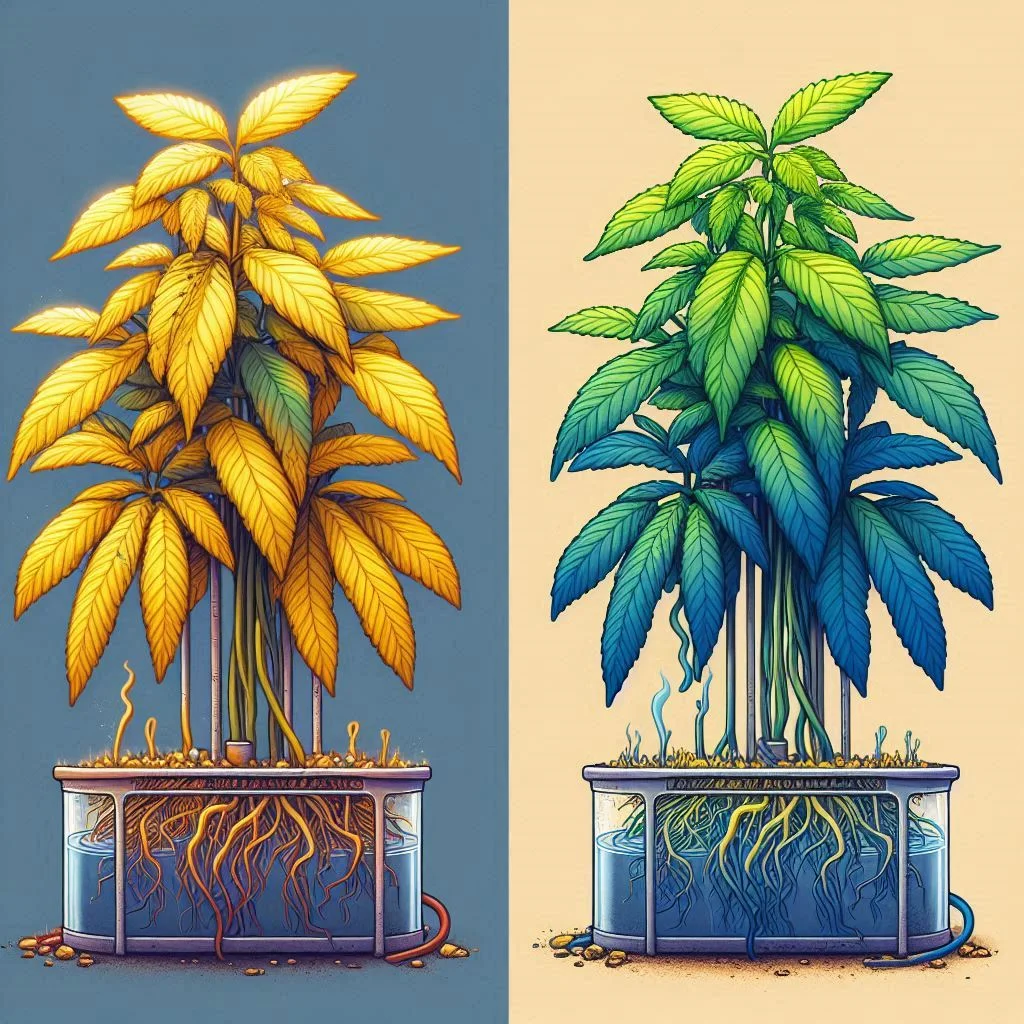
Understanding a Plant’s Vascular System in Hydroponic Environments
The vascular system in plants is responsible for transporting water, nutrients, and hormones. In hydroponics, this system must function efficiently since plants rely entirely on nutrient-rich water rather than soil.
1. Xylem: Water & Nutrient Transporter
- The xylem moves water and dissolved nutrients from the roots to the leaves.
- In hydroponic plants, proper aeration and water circulation ensure strong xylem function.
2. Phloem: Nutrient & Sugar Distributor
- The phloem distributes sugars and hormones from the leaves to other plant parts.
- Poor nutrient management can clog the phloem, causing stunted growth.
Optimizing Vascular Health in Hydroponics
Maintain proper oxygenation in nutrient solutions to avoid root suffocation
Use balanced nutrient solutions to prevent vascular blockages
Monitor water temperature (65-75°F) to avoid stress on vascular function
Defending Plants Against Pathogens with Proper Climate Control
A controlled hydroponic environment reduces the risk of diseases and pathogens. However, without proper climate management, plants can become vulnerable to infections like root rot, powdery mildew, and bacterial wilt.
Key Climate Control Factors for Disease Prevention
Humidity Regulation (50-70%)
- Excess humidity promotes fungal diseases like powdery mildew.
- Low humidity causes nutrient uptake issues and plant stress.
- Use dehumidifiers or misting systems to maintain balance.
Air Circulation & Ventilation
- Stagnant air creates hot spots, leading to moisture buildup and mold growth.
- Install oscillating fans or exhaust vents to ensure continuous airflow.
Temperature Control (65-80°F)
- High temperatures speed up ethylene production, causing premature ripening.
- Low temperatures slow down nutrient absorption, weakening plants.
UV Sterilization for Disease Prevention
- UV-C light kills fungi, bacteria, and viruses in the air and water.
- Many hydroponic growers use UV sterilizers in nutrient reservoirs to prevent pathogen buildup.
Basics of Flexible Ducting for Hydroponic Air Conditioning
In hydroponic farming, maintaining optimal temperature, humidity, and air circulation is essential for plant health and maximum yields. Flexible ducting plays a crucial role in distributing fresh, cooled, or dehumidified air throughout the grow space, ensuring that plants receive the best possible environment.
This guide covers:
Why flexible ducting is essential in hydroponic systems
How to choose the right ducting materials for efficiency
Installation tips to optimize airflow and climate control
Mastering flexible ducting will help you create a well-ventilated, climate-controlled hydroponic setup that promotes healthy plant growth and prevents common issues like heat stress, mold, and stagnant air pockets.
Why Flexible Ducting Is Important in Hydroponic Setups
Flexible ducting is widely used in HVAC (heating, ventilation, and air conditioning) systems for hydroponics because it allows for easy installation, air direction control, and adaptability within grow rooms or greenhouses.
Key Benefits of Flexible Ducting in Hydroponics
Efficient Air Distribution
- Delivers cool, fresh air evenly across the grow space
- Helps maintain consistent temperature and humidity levels
- Prevents hot spots that can stress plants
Prevents Mold and Fungal Growth
- Enhances air circulation to reduce excess moisture buildup
- Keeps humidity levels balanced to avoid mildew and root rot
Optimized CO₂ Delivery
- Directs carbon dioxide (CO₂) where plants need it most
- Ensures uniform air mixing for better photosynthesis
Reduces Noise and Vibration
- Flexible ducting is quieter than rigid ducts, minimizing fan noise
- Helps maintain a stealthy, low-noise grow operation
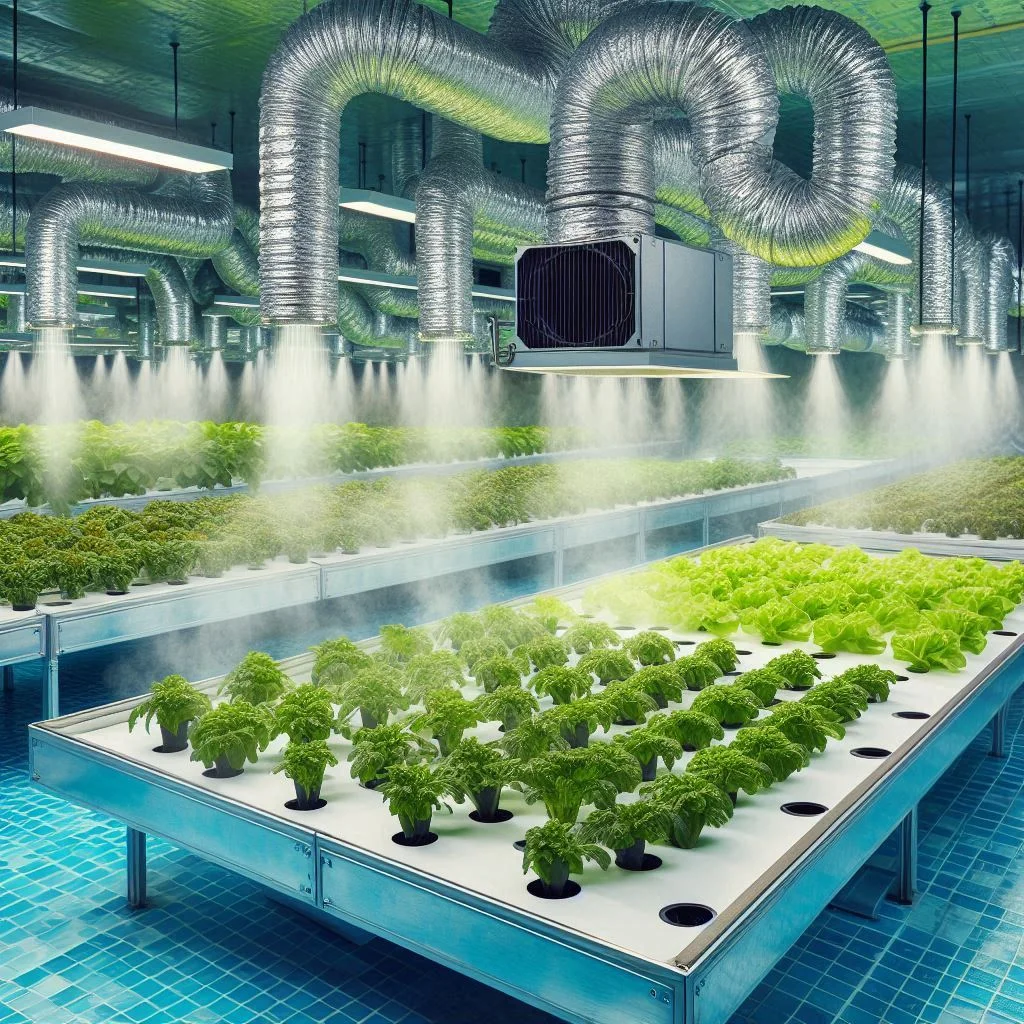
Choosing the Right Ducting Materials for Efficient Air Distribution
The type of ducting material you choose directly impacts the efficiency of airflow, durability, and energy consumption of your hydroponic HVAC system.
1. Aluminum Flexible Ducting (Best for High Durability)
Heat-resistant and prevents air leaks
Works well for high-powered ventilation systems
Ideal for large hydroponic greenhouses
Can be more expensive and harder to bend in tight spaces
2. Insulated Flexible Ducting (Best for Temperature Control)
Reduces heat loss or gain from external conditions
Prevents condensati

